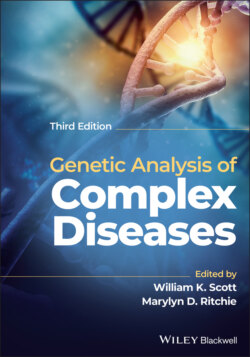Читать книгу Genetic Analysis of Complex Disease - Группа авторов - Страница 36
Genes and Alleles
ОглавлениеThe physical site or location of a gene is called its locus. At any particular gene locus, there exist different forms of the gene, called alleles. These alleles are unique from each other due to variations of the nucleotides or structure in the gene, which may result in altered function of the gene and/or gene product. These alleles are analogous to the factors of inheritance and variation identified in the 1800s by Mendel. Except on the sex chromosomes of males, an individual has two alleles at each locus. In some instances, a gene may exhibit homozygosity in its two alleles, meaning that both alleles are indistinguishable from each other. Such an example is the presence of two specific disease‐causing alleles of the HBB gene that together cause sickle cell anemia. In the heterozygous state, the two alleles can be distinguished from each other. Males with a normal chromosome complement represent an exception to this convention as they are “hemizygous” for loci on the X chromosome for which they do not have a Y chromosome complement.
The difference between two alleles may be as subtle as a single base‐pair (bp) change, such as the adenine‐to‐thymine substitution in the HBB gene that alters the B chain of hemoglobin A from its wild type to its hemoglobin sickle cell state. Alternatively, allelic differences can be as extensive as large, multicodon deletions, such as those observed in Duchenne muscular dystrophy. Some bp changes have no deleterious effect on the function of the gene; nevertheless, these functionally neutral changes in the DNA still represent different forms of a gene. Rare changes in the genetic code that cause functional change of the gene or protein are often termed “mutations,” while functionally neutral changes that are more common in the population (>1%) are given the name “polymorphism.” The term “pathogenic variant” is also commonly used to refer to rare genetic changes that cause functional change in the gene or protein. “Mutation” and “pathogenic variant” may be used interchangeably throughout the chapter.
Figure 2.5 Central dogma of genetics: DNA → RNA → protein.
(Source: Reprinted by permission from Jorde et al. (1995).)
Differences in alleles can be detected via laboratory testing. The ability to detect allele differences accurately within families, between families, and between laboratories is critically important for tracking the alleles that may be involved in Mendelian and genetically complex common disorders through linkage or association analysis. Allele detection strategies may be as simple as the presence (+) or absence (−) of a deletion or point mutation or as complicated as assessing the allele size in bp of DNA. The latter application is common when highly polymorphic microsatellite repeat markers are used in linkage analysis.
